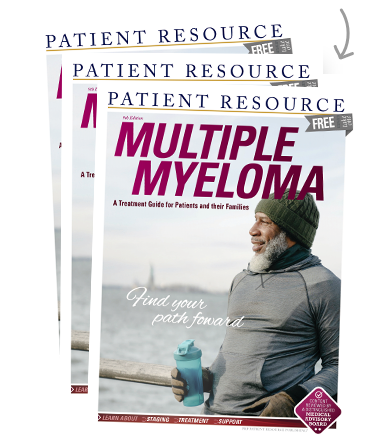Multiple Myeloma
Stem Cell Transplantation
Your treatment plan may include a stem cell transplant. Also called a bone marrow transplant, it is a procedure in which a patient receives healthy hematopoietic stem cells to replace damaged stem cells. The goal is to create a new immune system, helping restore the body’s ability to produce blood cells. Along with replacing stem cells, the donated cells in an allogeneic transplant may kill cancer cells that remain after high-dose conditioning. This is called the graft-versus-tumor effect.
Two main types of blood stem cell transplant are available. The most common type used for multiple myeloma is an autologous transplant. It uses your own stem cells. An allogeneic transplant uses donated stem cells from a family member or someone else who is often found through a registry (see Could You Save a Life?).
Helpful Pronunciations
Allogeneic (al-oh-jeh-NAY-ik)
Autologous (aw-TAH-luh-gus)
Haploidentical (ha-ploy-DEN-ti-kuhl)
Myeloma (MY-eh-LOH-muh)
Syngeneic (SIN-jeh-NAY-ik)
Stem cell transplants generally occur as follows
- Collection. Stem cells from you or a donor are collected, filtered and processed. The cells may be frozen and stored, and later thawed.
- Conditioning. High doses of chemotherapy or sometimes full-body radiation are used to destroy the cancer cells in the marrow, blood and other parts of the body. Reduced-intensity conditioning treatment that uses milder doses of chemotherapy and radiation therapy may be an option in an allogeneic transplant.
- Transfusion. Harvested stem cells are infused into your body through a vein.
- Recovery and engraftment. Within about 2 to 4 weeks, healthy cells begin to grow (engraft). While your weakened immune system recovers, you will be at risk for infection. This process often requires the ongoing use of prophylactic (preventive) antiviral and antibacterial medications. After recovery from the transplant, you may receive inoculations with childhood vaccines. The number of red blood cells, white blood cells and platelets will continue to be monitored until they are back to safe levels. Allogeneic transplant recipients also remain at risk for chronic Graft-versus-Host Disease (GvHD).
Understanding Graft-Versus-Host Disease
GvHD occurs when graft immune cells from a donor in an allogeneic bone marrow transplant recognize the patient’s own healthy cells as foreign and attack them. Donor tissue needs to match yours as closely as possible to reduce the chance of GvHD. Additionally, before your procedure, ask your doctor about a preventive drug that may help minimize the risk of acute GvHD as well as clinical trial options focused on preventing the onset of GvHD.
GvHD can be mild, moderate or severe, damaging your skin, liver, intestines and other organs. If GvHD emerges within 100 days of the transplant, it is usually classified as acute. Chronic GvHD usually appears later after the transplant and may require short-term or lifelong treatment.
Post-transplant, contact your doctor immediately at the first sign of any of these symptoms that signal the onset of GvHD:
- Abdominal pain and swelling or diarrhea
- Rashes, raised or discolored skin, skin thickening or tightening
- Yellow skin or eyes, dry eyes
- Taste changes or loss of appetite
- Frequent infections, unintentional weight loss
- Indigestion, abnormal gas or bloating
Support Is Key Pre- and Post-Transplant
A stem cell transplant requires significant preparation and help. If a loved one or friend is not available, consider hiring a temporary caregiver to help with these and other tasks:
- Schedule and take you for appointments and immunizations.
- Care for your dressings or central venous catheter, if applicable.
- Track and give medications, including through the catheter, if applicable.
- Check for signs of infection or other problems, and report changes to your medical team.
- Make healthy meals and encourage a healthy diet.
- Ensure you have access to psychosocial, physical and financial resources.
Could You Save a Life?
Registries are always in need of potential bone marrow donors, especially African American donors and anyone between the ages of 18 and 35. Visit NMDP at www.bethematch.org to see if you are eligible to donate. This unified organization of both Be The Match and the National Marrow Donor Program has one single purpose: to save lives.



